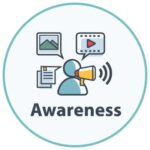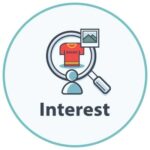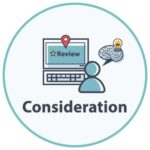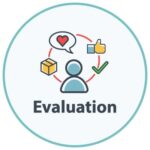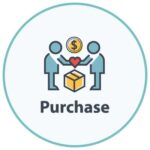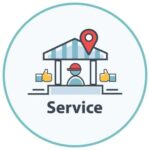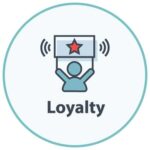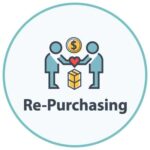Who Owns the Customer Journey?

Jump to a Section:
Awareness | Interest | Consideration | Evaluation | Purchase | Service | Loyalty | Re-Purchasing
Has anyone asked this question inside of your organization recently? If no one has, have you discussed every part of the SALES JOURNEY/Sales Process, as it aligns with your customer journey?
If you haven’t discussed either topic, you need to grab your manager, your boss, your CEO, and ask them to walk you through each stage of the journey and explain how your company is executing each stage better than your competitors. DO IT RIGHT NOW; don’t even worry about finishing this article!
Welcome back.
So how did that conversation go? My guess is that it wasn’t great.
Attracting new customers pre-Covid-19 was already becoming increasingly difficult, but attracting, winning and keeping customers today requires the type of alignment, communication and execution that I rarely see (read my article What Is Your Crisis Selling Playbook). Your company’s current customers and future customers are at risk if you do not act now!
My hope is that this article will prompt you to re-think, not only how you sell, but when you sell, who is involved in selling, and the systems and processes that support each step of the customer/sales journey.
Throughout this article, I will highlight each stage of a customer/sales journey. The image above will be used as our guideline throughout the journey. If there is a stage that you need to prioritize, feel free to utilize the hyperlinks at the top of the article to jump directly to that section. Once you have “solved” that section, please complete the rest of the article (use the RED ARROW on the right side of the screen to jump back to the top). This customer journey article applies specifically to a sale that includes both a product and a service. I will focus mostly on B2B selling, but the concepts certainly apply to B2C, as well.
As you move through the stages, think to yourself, who is interacting with the prospect/customer? Is this person/department best equipped to create an amazing experience for the prospect/customer? Is this person/department best equipped to move the prospect/customer to the next stage? If multiple departments are involved, how aligned are they? And finally, how would an organization (your organization) know if its sales journey/customer journey is optimized?
Challenge your thinking, my thinking, and your own organization’s thinking as you read this article. Review and answer the questions in each ACTION ITEM section. If you can’t answer, or don’t have a good answer for each question, your prospects/customers might not experience an optimized Customer Journey:
STAGE 1 – Awareness
As a potential buyer of a product/service, how do you become aware of that product/service? If you are of a certain age, you might answer: Radio, TV, Newspaper. If you are of a different age, you might answer: YouTube, Instagram, Snapchat, or Tik Tok. Regardless of your demographic, the internal department that typically handles awareness is the Marketing Department. Marketing is responsible for a Selling Company’s Search Engine Optimization (SEO), they are also responsible for its presence on social media, traditional media, and/or marketing events. This is how prospective buyers learn about the Selling Company’s business, and their products and services. Marketing 100% owns this phase of the customer journey.
Well, OK, as a well-known TV personality used to say, “NOT SO FAST, MY FRIEND.”
Do prospective Buying Companies/Customers sometimes learn, or become aware of a Selling Company’s products/services via a Selling Company’s Inside Sales Reps (ISRs) or Sales Development Reps (SDRs)? Who owns that team? In many organizations MARKETING “owns” the ISRs or SDRs, but in other organizations they are owned by sales.
Do perspective Buying Customers sometimes learn, or become aware of a Selling Company’s products via Business Development Executives or Territory Sales Reps? These roles are definitely owned by sales.
How about references, referrals, and/or influencers? How about 3rd party partners? What department owns these people?
ACTION ITEM – Answer the following:
- If different departments own different stages of the customer journey, or if different departments own different activities within the same stage, how can a company (your company) ensure that you are optimizing that stage, and the entire customer journey (Cross-functional communication is a vital part of success. Don’t run the risk of overlooking it)?
- What metrics is your company tracking to ensure that this phase of the customer journey is optimized?
Stage 2 – Interest
A flashy white paper = Marketing. A glossy product overview = marketing. An amazing “pitch-deck” = Marketing. Often Marketing aligns Awareness opportunities with Interest opportunities. “Let’s make them aware, and while we have them, let’s highlight to them why they should be interested.”
It appears that Marketing “owns” the Interest stage of the customer journey.
Yes, many SELLING Companies put white-papers, product overviews and even pitch-decks on their websites. Many marketing organizations also send out targeted, mass blast e-mails to designated personas to raise their interest in specific features or use cases. Fantastic.
What about individual SDRs or ISRs who craft their own messaging that they send in an email ALONG with white papers or product glossies? What about Sales People who do the same thing? What happens if you use channel partners? Still fantastic? Maybe, but is the messaging the same when it comes from Marketing vs. Sales/3rd party? Are all of the prospective customers having a similar experience as they “get to know” a Selling Company?
ACTION ITEM – Answer the following:
- Does your company want consistent messaging to your prospects and customers? (rhetorical)
- What metrics are you using to ensure that your approach to raising interest is working?
Stage 3 – Consideration
At this stage a Buying Company is now aware of you and they believe that your product seems “interesting.” But should they consider your product for their organization?
Consideration is the stage of the process that typically requires someone from the Buying Company to curate information, review that information, and then share the results of their investigation with others inside of their organization.
The Buying Company downloaded a white paper, and they are now reviewing it. They attended your on-line demo, and they are now sharing their findings with an internal review team. They are searching on-line user forums for any data that might help them to determine, “should I invest the time to dig deeper?”
Depending on the size of the Selling Company, they might have some data-mining experts inside of their organization who are tracking views, clicks, and downloads. Usually, these tech wizards are owned by marketing.
All Selling Companies want prospects to move to the Evaluation Stage, but often they need a helpful push. Who owns the push? Is Marketing passing on “MQLs” to inside sales or outside sales? Is a marketing person sending out additional glossies and white papers that will push a prospective buyer along?
ACTION ITEM – Answer the following:
- At this stage, who decides the criteria of what to push vs. what not to push? -Who decides what information should be placed into the Selling Company’s CRM?
- Has all of this been communicated?
- Who owns the communication piece?
- Is there alignment between all departments involved?
Stage 4 – Evaluation
Yes, finally, all of the sales people and sales executives who are reading this article are fired-up because this is a STAGE THAT THEY OWN! “Yes, finally, get marketing out of the way and leave the selling to the professionals.” But is that really the case? Does sales really “own” the Evaluation stage?
This is the stage when a potential buyer usually “meets” the “sales team.” In today’s world, whom is that buyer meeting? Is it one person, two people, more, a third party, or is it no one – simply a user interface? What are their titles? Do buyers know? Do they care, as long as that person, people, or interface enables them to feel comfortable with the value of the product?
What happens if the Selling Company is offering a free trial period, or some type of “freemeium solution” – is sales involved?
What happens if the Selling Company is “DEMOing” a product? Is a sales person the only person involved in that Demo? In the B2B world, the Selling Company often introduces prospective Buying Customers to a “pre-sales technical resource.” Who owns this technical resource? Are they helping to sell the product/service?
ACTION ITEM – Answer the following:
- What is your company doing pre-evaluation, during the evaluation, and after the evaluation to ensure that all resources are aligned?
- Are all of the resources involved in the Evaluation stage aligned?
- Are all of the resources involved in the Evaluation stage communicating effectively?
- What type of processes and systems does your company have in place to ensure that the evaluation experience is optimized for your prospective customers?
- Do you have an effective strategy that shows ROI?
- If you were to ask ten people from your sales organization and ten people from any organization that supports this stage, “What does an optimized evaluation stage look like?” – would you get the same answer (be prepared to be shocked)?
Stage 5 – Purchase
The Buying Company believes that the Selling Company’s product or service is better than their competitors, or they believe that the price/value ratio is better than the other competitors, and they choose to buy.
Depending on the size of the deal, the buying company might simply enter their credit card information and viola’ the technology is working, or they might need legal, IT, and others to become involved.
If other departments from the Selling organization are involved before the purchase agreement is signed, how easy is this process for the Buying organization?
If the Selling Company is selling services along with a product, when does the Buying Company meet that team, before or after the sale? How much does the Buying Company know about that team? How much does the buying company trust new team?
What is the overall plan of the Selling Company to ensure that the Buying Company gets the most value from its product? Since we are talking about the sale of a Product AND a Service, does Sales really care if the product helps drive business results for the Buying Company? Does the Services team really care if the product helps drive business results (do they even know about the Buying Company’s desired business outcomes?) for the Buying Company, or are they more concerned about finishing their “part” of the sale.
Many Selling Companies feel and ACT that the sale ends here, but for companies that sell products and services, this could be the beginning of larger sales, or if the service implementation fails, it will truly be the END of the sale (and end of the customer journey).
ACTION ITEM – Answer the following:
- If there are hand-offs that occur within your organization at the purchase stage, how clear is every participant about their role during the hand-off?
- How consistent are these hand-offs?
Stage 6 – Service
In most B2B companies, Sales leaves the Customer Journey at this point, and the professional services department takes over.
So who owns the Customer Journey at this stage? Well, I have already said it, it is Professional Services!
Who owns the Sales Journey at this stage? I am not trying to be funny here; I would really like you to answer this question. Is it Professional Services? Is it Sales? Is it your Success Organization? Is it, “I don’t really know”? For many of our clients, unfortunately, it is the later.
In our Covid -19 world, and in the post Covid-19 world, I believe that this stage is the BIGGEST opportunity for Selling Companies to sell.
I do realize that this is a strong statement, but if you think about the best opportunities for a Selling Company to form relationships, do deeper discovery about a Buying company’s needs and desired business outcomes, I feel that it happens at this stage!
The Selling Company is working with the Buying Company. The Selling Company is learning about the Buying Company’s world. The Selling Company is “inside the Buying Company’s fence.”
All things being equal, who does a Buying Company resource TRUST more at this stage: a Professional Services resource or a Sales person?
If you see an opportunity for sales to happen during this stage, please know that it requires many structural and systemic changes BEYOND simply telling Professional Services – “Go ahead and sell.”
ACTION ITEM – Answer the following:
- How aligned are sales and services inside of your organization?
- Is there clear direction for Services to SELL during the Services stage?
- Is there incremental compensation involved, if a services person does “sell” something?
Stage 7 – Loyalty
Loyalty has long been a focus of Sales organizations. The general premise has always been loyal customers buy more, are more willing to try additional services, and refer more.
Beginning in 2003, Fred Reichheld introduced the concept of the Net Promoter Score® NPS® to help prove this general premise. And an overwhelming amount of data that has been gathered since 2003 proves that loyal customers are incredibly valuable.
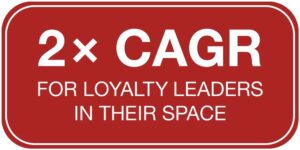
Data from Bain & Co highlights that companies who are able to become loyalty leaders within their space typically have more than a 2x CAGR vs. the average companies within their vertical. Their data also suggests that the customers of these loyalty leaders buy more, stay longer, refer friends, and provide feedback.
Most B2B product/services companies have created Customer Success teams to interact with current customers to ensure that they are satisfied.
So what exactly is the role of this Customer Success team? Are they simply calling customers and asking them, “how are you doing?” Maybe. Are they connecting with the “most important” companies and offering them special “deals”? Maybe. Are they collecting data for the sales person to use? Are they putting information in the CRM? Are they communicating with professional services?
We have seen and worked with Customer Success teams who do all of the above.
I’m not sure if there is one model for Customer Success that’s perfect, but I can tell you that if you are looking to optimize your Customer Journey, the communication between Customer Success and the rest of the organization needs to be perfect.
ACTION ITEM – Answer the following:
- Does Customer Success own Stage 7?
- Is the sales person who initially sold the business still involved?
- Is someone from Professional Services still delivering services to the account?
- Is someone else from the Selling Company attempting to expand the business into other parts of the Buying Company?
- How many additional people could be involved?
- With this many people involved, is there a chance that customer loyalty could be negatively impacted?
Stage 8 – Re-Purchasing
Or more commonly known as – Renewal.
Does the journey end here, or does it start again?
Hopefully, the Selling Company has been tracking the use and success of everything that has happened since the Buying Company decided to buy their product and service.
Hopefully, multiple resources from the Selling Company have interacted with multiple resources from the Buying Company, and each of them has demonstrated skills and knowledge that have proven invaluable in helping the Buying Company to reach/surpass their desired business outcomes.
Hopefully, months before the Buying Company’s contract runs out, a resource from the Selling Company reaches out to ensure that the Buying Company is still loyal (see stage 7).
Hopefully, someone from the Selling Company has completed a SWOT analysis and is well aware of the likelihood that the Buying Company will choose to stay.
I heard someone say once that “hope is not a strategy” – and it’s not.
Instead of the discipline that is described above, more often than not, we see behavior that looks and sounds like this:
“Hi, it ‘s Bob calling from Widgets R S. It is time for your renewal, are you ready to renew?”
No review, No plan, No proof of value, and quite often, No Renewal.
ACTION ITEM – Answer the following:
- Who owns the renewal process?
- When should someone from renewal reach out, what should they say?
- Who else should be involved?
- What type of information and data should be documented about the client’s willingness to renew or not?
- How does our early stage thinking (Stages 1-5) – “How do we get a prospect to want to buy?” – differ from our late stage thinking? (Stages 6-8) – “How do we ensure that the customer actually gets value from what they bought, so they will want to buy again?”
Congratulations, you made it through a long article with quite a few action items. How do you feel?
Are you overwhelmed? Fine, I have given you a recipe that will help you to alleviate that feeling. Follow it, even if it is only one Stage at a time. Move forward; don’t be complacent.
Do you feel confident? Great, if you have successfully answered all of the Action Item questions, you should be. But, what you shouldn’t be is overconfident. Covid-19 has proven to all of us that the world is always changing, which means that customer sentiment, market demands, and product emphasis will always change, too. Even if your firm is winning right now, you need to be prepared to pivot.
Are you feeling pessimistic? Are you thinking that this too shall pass? I promise you, it is not going to pass. The world of marketing and sales “owning” the Customer Journey is gone for good. If your firm does not embrace a new approach to collaboration/communication, be prepared for your competitors to own “your customer’s journey.”
LIFT can help to protect your customers, and to add new ones. Get in touch with us today, and let’s discuss how.
robertlogue@liftsalesforce.com
